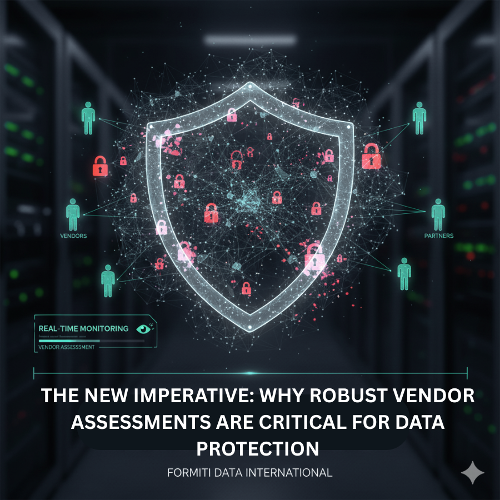The New Imperative: Why Robust Vendor Assessments Are Critical for Data Protection (And How to Fix Your Broken Questionnaires)
In today's interconnected digital economy, no business operates in a vacuum. Your data flows not just within your own walls, but through a complex web of third-party vendors, suppliers, and partners. This ecosystem is essential for growth, but it's also your single greatest data protection vulnerability. A data breach originating from one of your vendors is, in the eyes of regulators and your customers, your data breach.
The old model of sending a static, 200-question Excel spreadsheet once a year is no longer defensible. It's a "check-the-box" exercise that creates a false sense of security.
This article explores the critical importance of modern vendor assessments for data protection and provides a clear roadmap for improving your assessment quality. It also introduces an advanced solution that moves beyond static forms to real-time, proactive risk management.
1. The High Stakes: Why Vendor Assessments Are Non-Negotiable
Relying on outdated or superficial vendor assessments is a high-risk gamble. The consequences of third-party risk are severe and multifaceted.
- Mitigating Catastrophic Cyber Risks: Vendors are a prime target for attackers. A compromised third-party, such as an IT service provider or a marketing platform, can provide a "back door" into your most sensitive systems. A thorough assessment identifies and helps mitigate these technical vulnerabilities before they can be exploited.
- Ensuring Regulatory Compliance: Global data protection laws like the GDPR, CCPA, and the evolving framework of the EU-US Data Privacy Framework (DPF) hold you directly accountable for the data you share. Article 28 of the GDPR, for example, legally requires you to conduct due diligence on your data processors to ensure they provide "sufficient guarantees" to protect personal data. Failure to do so can result in crippling fines.
- Protecting Your Brand and Reputation: A public-facing data breach, even if caused by a vendor, erodes customer trust in an instant. The reputational damage and subsequent loss of business can often be far more costly than any regulatory fine.
- Avoiding "Unknown-Unknowns": Do you know if your vendor is sub-contracting their services? Do you know where your data is really stored? A robust assessment process maps this entire data supply chain, turning unknown risks into manageable, known quantities.
2. The Problem with "Traditional" Questionnaires
Most vendor assessment programs are broken. They rely on static, one-size-fits-all questionnaires that are inefficient for you and frustrating for your vendors.
Common failures include:
- One-Size-Fits-All: Sending the same exhaustive questionnaire to a high-risk payment processor and a low-risk office supply company. This wastes time and alienates partners.
- Point-in-Time Error: An assessment is only valid the moment it's completed. A vendor's security posture can change dramatically a week later due to a new vulnerability, a system change, or a new sub-processor.
- Lack of Verification: How do you know the answers are accurate? Static questionnaires are based on self-attestation, with no mechanism for real-time validation or continuous monitoring.
- Manual, Inefficient Process: Chasing vendors via email, manually tracking responses in spreadsheets, and trying to score risks by hand is a recipe for error and inconsistency.
3. How to Improve the Quality of Your Vendor Assessment Questionnaires
A modern, effective vendor assessment strategy is not about asking more questions—it's about asking the right questions at the right time.
? Step 1: Tier Your Vendors by Risk
Before you send any questionnaire, classify your vendors. A risk-based tiering system allows you to focus your efforts where they matter most.
- Tier 1 (High Risk): Vendors with direct access to sensitive personal data, financial information, or critical systems (e.g., cloud providers, payroll processors, CRM platforms). These require your most in-depth assessments.
- Tier 2 (Medium Risk): Vendors with indirect or limited access to sensitive data (e.g., marketing analytics tools, external support services). A more standardized assessment (like a SIG-Lite or CAIQ) may be appropriate.
- Tier 3 (Low Risk): Vendors with no access to sensitive data or critical systems (e.g., office cleaning services, catering). A simple policy attestation may be all that's required.
? Step 2: Use Smart, Dynamic Questionnaires
Stop using static templates. Your assessment platform should dynamically adapt the questions based on the vendor's tier and the services they provide. If a vendor states they do not process personal data, they should not see 50 questions about GDPR.
? Step 3: Move from "Point-in-Time" to "Continuous Monitoring"
A vendor assessment should be a living process, not an annual event. This involves:
- Integrating external threat intelligence feeds.
- Setting up alerts for security incidents related to your vendors.
- Requiring vendors to re-attest to key controls on a more frequent, automated basis.
? Step 4: Make It a Collaborative Process
The goal is risk mitigation, not just auditing. Your assessment process should be a tool for collaboration. When a risk is identified, the platform should create a clear remediation plan with assigned tasks and deadlines for both your internal team and the vendor.
5. Frequently Asked Questions (Q&A)
Q: Why can't I just rely on a vendor's ISO 27001 or SOC 2 certification? A: Certifications are an excellent starting point, but they are not a substitute for your own due diligence. A SOC 2 report, for example, is a "point-in-time" audit and its scope (the "Trust Services Criteria") may not cover all the specific risks relevant to the data you are sharing. Your assessment must fill those gaps.
Q: How do we get our vendors to actually complete these questionnaires on time? A: The key is to make the process as painless as possible. Use a modern platform (like Privacy360) that provides a simple, user-friendly portal for the vendor. Dynamic questionnaires that only ask relevant questions will also dramatically increase cooperation, as you show you respect their time.
Q: What is the single most important thing to look for in a new vendor? A: Beyond the service itself, look for transparency. A vendor that is open and forthcoming about its security and privacy practices—even its weaknesses—is a far better partner than one that is evasive. A good vendor will see your due diligence as a sign of a mature and valuable partnership.
Q: How does this relate to the EU-US Data Privacy Framework (DPF)? A: The DPF is a prime example of why vendor assessment is critical. To legally transfer data to a US vendor under this framework, you must first verify that they are on the DPF list. This verification is a core function of a modern vendor assessment program.
Formiti Data International, through its Privacy360 platform, empowers your organization to turn third-party risk management into a proactive strength, building resilient data protection that safeguards your reputation, ensures compliance, and secures your invaluable data assets.

